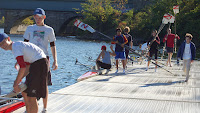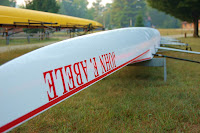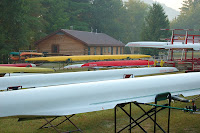Saturday, September 29, 2007
Thursday, September 27, 2007
Pasta and the Crew Race
Rowers:
Why pasta the night before a crew race?
The adequate consumption of carbohydrates is necessary for the preservation of protein for muscle tissue repair and maintenance. It is essential that the athlete consume carbohydrates before, during, and after exercise to sustain sufficient muscle glycogen levels.
Muscle glycogen stores are most diminished during endurance exercise (like rowing). Therefore, the ingestion of carbohydrates within 24 hours before and after strenuous activity is crucial for the replenishment of muscle glycogen.
The type of carbohydrate ingested is a key variable in the earliest replenishment following an extended bout of exercise. The pre-exercise carbohydrate should have a moderate glycemic index like pastas and whole grains. The post-exercise carbohydrate should have a high glycemic index like corn flakes, honey, white bread, rice, carrots, and bananas.
Nancy Clark of Sports Medicine Systems Inc. suggests that with morning events the athlete should eat a hearty, high carbohydrate dinner and a bedtime snack the night before. In the morning eat a light meal of toast and /or cereal to stabilize blood sugar levels, absorb some of the gastric juices and to keep from feeling hungry. For afternoon competitions the athlete should consume a hearty breakfast and a light carbohydrate-based lunch.
Bibliography:
- LaGary, Carter (Valdosta State University), Nutrition and Recovery.
- Kuster, Shawn, "Preparing for a National Competition," Sport Medicine and Science Council of Saskatchewan.
Posted by Coach at 8:25 PM 0 comments
Wednesday, September 26, 2007
Race Start Cadance
Rowers (especially Coxswains):
Listen to the start cadance of this crew. The coxswain, in time with his rowers, makes his calls very clear as he progresses through a 1 minute 30 second start piece. Rowers, notice how, at full pressure, there is composure in the stroke man's face and control in everybody else's blades even as they row at 40+ strokes per minute.
Courtesy of YouTube
Posted by Coach at 8:28 AM 0 comments
Tuesday, September 25, 2007
Plyometrics: What Are They?
Rowers:
Speed and strength are integral components of fitness found in varying degrees in virtually all athletic movements. Simply put the combination of speed and strength is power. For many years coaches and athletes have sought to improve power in order to enhance performance. Throughout this century and no doubt long before, jumping, bounding and hopping exercises have been used in various ways to enhance athletic performance.
In recent years this distinct method of training for power or explosiveness has been termed plyometrics. Whatever the origins of the word, the term is used to describe the method of training which seeks to enhance an individual's "explosive" reaction through rapid and powerful muscular contractions.
PLYOMETRIC EXERCISES:
LOWER BODY
Drop Jumping: This exercise involves the athlete dropping (not jumping) to the ground from a raised platform or box, and then immediately jumping up. The drop down gives the pre-stretch to the leg muscles and the vigorous drive upwards the secondary concentric contraction. The exercise will be more effective the shorter the time the feet are in contact with the ground. The loading in this exercise is governed by the height of the drop that should be in the region of 30 to 80 cm. Drop jumping is a relatively high impact form of plyometric training and would normally be introduced after the athlete had become accustomed to lower impact alternatives, such as two-footed jumping on the spot (jumpies).
Bounding and hurdling: If forward motion is more the name of your game, try some bounding. This is a form of plyometric training, where over sized strides are used in the running action and extra time spent in the air. Two-legged bounds reduce the impact to be endured, but to increase the intensity one legged bounding, or hopping, can be used. Bounding upstairs is a useful way to work on both the vertical and horizontal aspects of the running action. Multiple jumps over a series of obstacles like hurdles are valuable drills for athletes training for sprinting or jumping events.
UPPER BODY
Press ups & hand clap: Press-ups with a hand clap in between is a particularly vigorous way to condition the arms and chest. The pre-stretch takes place as the hands arrive back on the ground and the chest sinks, and this is followed quickly by the explosive upwards action. Once again, to get the best training effect keep the time in contact with the ground to a minimum.
Medicine Ball: Another means of increasing upper body strength popular with throwers is to lie on the ground face up. A partner then drops a medicine ball down towards the chest of the athlete, who catches the ball (pre-stretch) and immediately throws it back. This is another high-intensity exercise and should only be used after some basic conditioning.
Posted by Coach at 8:37 PM 2 comments
Thursday, September 20, 2007
Race Lineups
Rowers:
With our first race just around the corner (September 29), I want to be clear how boatings will be made. We have two eights worth of freshmen athletes; therefore, I will refer to the boats as the freshmen eight and novice eight.
Neither eight is considered a priority, because I will be coaching both boats equally. And, it is my goal to bring out the potential strength and speed of every athlete in both crews.
The freshmen eight will be the faster of the two eights - freshmen races typically finish with times faster than novice races. I will set the boats based on three criteria:
- Improvement on the water;
- Improvement on the erg; and
- Attendance.
As freshmen athletes who are new to sweep rowing, it is less important for me to boat based on strength. I will look for rowers who are focused on learning the appropriate way to row and who are dedicated to our team goals. Don't hesitate to ask me at practice about your seat. Just don't ask me about somebody elses...we are a team.
Posted by Coach at 8:28 PM 0 comments
Wednesday, September 19, 2007
Coxswain's Perspective
Rowers:
The following video was filmed by the coxswain of the Los Gatos Rowing Club's Varsity Men's Eight.
Although the video is choppy, notice the calls the coxswain is making. Every stroke, emphasized on the catch, he is directing the crew. The coxswain delivers the strategy, keeps the timing, triggers the adrenaline rush, and serves as the eyes of his crew.
Courtesy of YouTube
Posted by Coach at 9:12 PM 0 comments
Saturday, September 15, 2007
Resistance Training Program
Rowers:
Your goal, if you choose to participate in a resistance training program, is to build strength. This complements our water training, which focuses heavily on technique and endurance. Each resistance training session should last only 30 minutes or less with only 2 to 3 sessions per week. Please follow this program carefully.
THE PROGRAM
- Stretch at the beginning of each session
- Ask the gym teacher or instructor to help you determine your 1 rep max or to show you the proper way to do each exercise from the list below if you are uncertain
- Each day, choose 6 exercises from the list, with at least one from each set
- Perform 2 sets per exercise of 8-10 reps each at about 75% your 1 rep max
- Allow 45-60 seconds rest between sets
- Stretch after each session
Note 1: Know your exercises beforehand so you can rotate through the session efficiently
Note 2: Try a unique exercise routine each session
THE EXERCISES
Lower Body
- Squats
- Leg Extensions (quadriceps)
- Leg Curls (hamstrings)
- Dumbbell Lunge
- Calf Raise
- Leg Press
Core
- Lower Back Extensions (aka: Superman)
- Cleans
- Sit-Ups (option to use a medicine ball)
- Elbow-Knee Touches
- Plank Holds
Upper Body
- Bench Pulls
- Upright Rows
- Bicep Curls (w/barbell)
- Overhead Extensions (triceps)
- Flys
- Bench Press (w/free weights)
- Lat Pull Down
Posted by Coach at 9:23 PM 1 comments
Wednesday, September 12, 2007
Coxswain's Responsibilities
Rowers:
What exactly is the coxswain's role on the freshmen team.
1. Safety. The coach and the coxswains together ensure that you, the rowers, are safe. Whereas the coach makes sure your technique is proper to avoid injury, the coxswain makes sure he steers you safely down the river, reminds you to re-hydrate when there are a few seconds to catch your breath, and report to the coach any comments on rower fatigue and complaints. Safety is the first and foremost responsibility.
2. Motivation. The coxswain needs to learn what charges each rower. Is it competition? Is it teamwork? Is it personal achievement? Coxing is not just a series of calls...it is not "row row row." Absolutely not. If the rowers don't respond to a certain call, figure out what call does elicit the desired response. It is very much a problem solving role. Go home after practice and think about what calls worked and what calls didn't. Discard the ineffective and rehearse the effective.
3. Be Prepared. Ready rowers: THE COXSWAIN IS NOT RESPONSIBLE FOR YOUR WATER BOTTLES! Figure it out. Bring your water down when you bring the oars down. Bring it down before warm-up. But do NOT throw your water bottle into the coxswain's arms just before we get hands on the boat. Coxswains, you must have in your hands a cox box, headset, and head band. If you remember, bring some tools for quick fixes in the boat. Most importantly, your cox box must be charged. Please do not be on the dock and discover your box is out of battery. Charge it after practice!!! Once the boat is on the dock, no one should be running back up to the boathouse. You and the Captain will make sure both sets of oars are down before warm up. If there's another pair, rowers, grab them.
4. Be On Time. Coxswains, please always keep an eye on the time. When we are boating out, it should not take more than 3 or 4 minutes. Same thing for when we dock at the end of practice. You must be in control of where your rowers are. Make your calls efficient and clear. "Starboards stay with the boat, Ports oars." "30 seconds." "Starboards, run out your blades." "Starboards, one foot up and in." "Starboards hold, Ports in." "Countdown from bow when ready." "1..2..3..etc." "Push off the dock in two: 1...2" And your off. This is a system.
5. Protect the Equipment. When our hands are on the boat, the coxswain is the only one voice. Protect the skeg and rutter with your life. Remind the rowers of the riggers in the boathouse. Make sure the boat doesn't scratch against other boats. "Shoulders in 2." "Hands in 2." "Heads in 2." Etc. Make the calls LOUD and CLEAR. LOUD and CLEAR!
We are developing a routine, something that will be done the same everytime we row.
Posted by Coach at 9:37 PM 16 comments
Monday, September 10, 2007
The Boat Race
The Oxford and Cambridge Boat Race
The idea for a rowing race between the Universities of Oxford and Cambridge came from two friends - Charles Merivale, a student at Cambridge, and his Harrow schoolfriend Charles Wordsworth (nephew of the poet William Wordsworth), who was at Oxford. On 12 March 1829, Cambridge sent a challenge to Oxford and thus the tradition was born which has continued to the present day, where the loser of the previous year’s race challenges the opposition to a re-match.
On 12 March 1829, Cambridge sent a challenge to Oxford and thus the tradition was born which has continued to the present day, where the loser of the previous year’s race challenges the opposition to a re-match.
On Race Day up to 250,000 spectators crowd the banks of the Thames from Putney to Mortlake to witness the action. Cambridge currently lead the series since 1829 by 79-73.
Part I
Part II
Posted by Coach at 8:52 PM 1 comments
Sunday, September 9, 2007
Rowing in 19th Century New York
Excerpt from “The Wild and Crazy Professionals”
By Bill Miller 
If you’re like me, you have a very squeaky clean image of rowing. It is a sport of honor, pure competition, and strong camaraderie. Whether in victory or defeat, you respect your competitor and develop a bond with everyone who rows. In the 19th Century, rowing had a very dark side. Cheating, interfering, throwing and fixing races, damaging equipment, and poisoning and threats of death were known to occur. The professional rowing crowd in the 1800s would fit right in with the infamous 1919 Chicago "Black Sox." From fishermen and whalers to pilot gigs and life-savers, from naval frigate tenders and harbor ferries to Whitehall taxis and ships’ provisioners, many people pulled an oar for a livelihood. This led to contests, although fairly disorganized, and caught the public’s attention and interest. With this attention and interest grew the opportunity to make a quick dollar by betting on the outcome.
From fishermen and whalers to pilot gigs and life-savers, from naval frigate tenders and harbor ferries to Whitehall taxis and ships’ provisioners, many people pulled an oar for a livelihood. This led to contests, although fairly disorganized, and caught the public’s attention and interest. With this attention and interest grew the opportunity to make a quick dollar by betting on the outcome.
The top professional oarsmen were the famous figures of their day. Many were the New York Whitehallers who were the taxis of the day. They would row passengers across the East and Hudson Rivers for a fee. Being a faster sculler attracted more fares. Races between them showed professional supremacy.
Each oarsman or crew had a committee of supporters or backers that served as managers. They would make all arrangements for a race including raising the cash prize. The backers would then set out to book bets on the race and they would reward their oarsmen for a successful venture. Huge sums of money were bet and many times less than upright people bet more than they could afford to lose. If there was a way to influence the outcome in favor of your sculler or crew then it was tried. Samuel Crowther wrote in Rowing & Track Athletics in 1905:The professional racing drew the crowds and created the public excitement; a race between prominent scullers or crews was witnessed by from ten to fifty thousand people, and the betting was like that on a horse-race. The modern police arrangements were unknown, and the referee seldom decided against the home crew; the patriotism of the small town for its base-ball team is as nothing compared with the feeling in New York for the Biglins or other favorites, and that of the Hudson dwellers for the Wards.
Courtesy of Friends of Rowing History
The visiting oarsman had little chance; if the crowd did not break his boat before the start, he would have to run a gantlet of crafts as soon as he took the lead, and many a man had his boat cut in two by a barge when leading toward the finish. In one of Ellis Ward’s races on the Harlem against a number of local favorites, he had to dodge four barges that went at full speed for him, and, all else failing, the boats massed at the finish so that he could not cross on the proper side of the stake-boat, and then the opponents claimed that the race should not be given to him because he had not finished in the correct place. It was the universal custom for the leading boat to give the nearest competitor the "wash" and every trick possible was played. The referee was the sole judge, and if he decided a race a draw, no matter what the outcome had been, the bets were off, and there are several recorded cases where such a decision was given simply because the home crew had been heavily backed and had lost.
Posted by Coach at 3:14 PM 0 comments
Thursday, September 6, 2007
Team Captain
Rowers:
Soon, we will select a team Captain for the fall season. His main responsibilities are two:
- To disperse information to the crew as directed by the coach; and
- To present team concerns to the coach.
The process for choosing Captain will be something like this:
First, coach will invite nominations from the team. Who do you think will best fit the role of Captain for our team and lead us towards accomplishing our team goals? If you think you fit the role, don't hesitate to nominate yourself.
Second, coach will make sure everybody who was named accepts their nomination. Before you say "yes," carefully consider the responsibilities of Captain. Can you make the commitment?
Finally, each athlete, including the nominees, will have two votes. Coach will call out each name and you will vote by raising your hand. (You can vote for yourself). The rower with the most votes will be the Captain and the rower with the second number of votes, his replacement if absent.
Think hard and good luck.
Posted by Coach at 8:13 PM 32 comments
Wednesday, September 5, 2007
Men's Dutch Eight
Rowers:
Please watch all 5 minutes of this video of the dutch men's eight practicing. This crew won the 1996 Olympics. Although there is no sound, this eight is a nice demonstration of proper rowing.
Courtesy of YouTube
Posted by Coach at 8:03 PM 1 comments





































